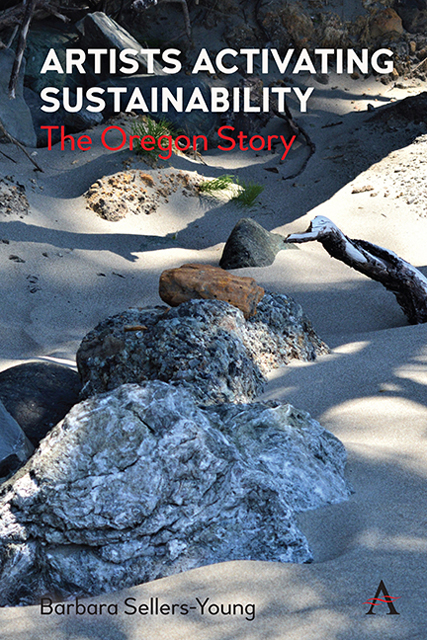Book contents
- Frontmatter
- Dedication
- Contents
- Acknowledgments
- List of Figures
- Introduction: Art, Environment and Metaphor
- 1 Environmental Activism, Arts and the Land of Eden Landscape One: High Desert Basin and Range
- Landscape One High Desert Basin and Range
- Landscape Two Columbia Gorge and Plateau
- Landscape Three Cascade Range
- Landscape Four The Willamette Valley
- Landscape Five Rogue River Valley
- Landscape Six Oregon Coast and Coast Range
- Index
6 - Portland’s Elisabeth Jones Art Center and Signal Fire
Published online by Cambridge University Press: 10 January 2023
- Frontmatter
- Dedication
- Contents
- Acknowledgments
- List of Figures
- Introduction: Art, Environment and Metaphor
- 1 Environmental Activism, Arts and the Land of Eden Landscape One: High Desert Basin and Range
- Landscape One High Desert Basin and Range
- Landscape Two Columbia Gorge and Plateau
- Landscape Three Cascade Range
- Landscape Four The Willamette Valley
- Landscape Five Rogue River Valley
- Landscape Six Oregon Coast and Coast Range
- Index
Summary
Portland leads the U.S. in “green-living” indexes, and Portlanders have become poster children for urban growth boundaries, public transportation, cycling, recycling, and green architecture.
Richard SpeerDriving north on Interstate 5 to Portland, I see Mt. Hood dominating the sky line. This mountain, which is only 20 miles east of the city, is a designated active volcano that has consistently erupted over the last 500,000 years. “In fact, geologic studies of the Mount Hood region have identified products of numerous local volcanoes that post-date the great floods of basalt lava (the Columbia River Basalts) that flowed down ancestral valleys of the Columbia River between about 16 and 15 million years ago.” The other dominating geographic feature is the flow of the Willamette River into the Columbia.
The initial name given to the area of today's Portland was the Wapato Valley, a reference to the root-based food that was a staple (also called Camas). This included Sauvie Island the 24,000 acres to the west of the confluence of the Columbia and Willamette Rivers. Wapato Valley inhabitants were organized as distinct villages that shared a common language and culture. The chief of a village was wealthy from the trade along the Columbia and Willamette Rivers and often had more than one wife and many slaves. The Wapato Valley people lived in multifamily red cedar plank houses that had a central hearth and individual family sleeping berths along the walls. “Wives were preferentially from outside villages and were not related by blood to their husbands. Marital ties carried economic rights with them, creating socioeconomic networks that tied villages together.” They used basalt to create tools for everyday life—bowls, pestles, mauls, and axes as well as anthropomorphic sculptures from small amulets to public monuments. The majority of the residents of the Wapato Valley died during the early eighteenth century from diseases brought by the fur traders (Figure 12 ).
In 1846, Francis Pettygrove, arrived, built a business and gave Portland its name after the city in his home state of Maine. Portland's water-based location made it an ideal transit center for those moving agricultural and lumber products from the Willamette Valley to the ports of San Francisco, Seattle, and those in Asia via the Columbia River and the open waters of the Pacific Ocean.
- Type
- Chapter
- Information
- Artists Activating SustainabilityThe Oregon Story, pp. 107 - 120Publisher: Anthem PressPrint publication year: 2022



